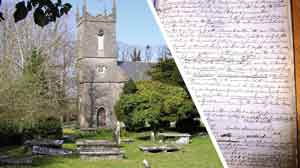KINDRED LINES: Finding Burial Records
Published in Features, Issue 4 (July/August 2022), Volume 30By Fiona Fitzsimons
After 1536 the Church of Ireland, as the established church, was responsible for burying all the dead of the community. Most parishes kept only a record of their own faith community. Notable exceptions were St James’s CoI (Dublin) and St Flannan’s CoI Cathedral graveyard, Killaloe (Clare).
Some faiths only buried their own dead and kept separate registers, including Quakers (after the 1660s), Huguenots (from the 1690s), Jews (from the 1720s) and Moravians (1750s). After Catholic Emancipation in 1829, some Catholic parishes began to keep their own burial records for the first time.
In 1875, responsibility for burials was transferred from the Church of Ireland to the new sanitary authorities: borough corporations and town boards in urban districts, and boards of guardians in rural districts and in towns with a population of less than 6,000.
The Local Government (Ireland) Act, 1898, brought the sanitary authorities under the control of county or district councils. They opened new burial-grounds and took responsibility for some older ones. In 1925, on the abolition of the rural district councils, these burial-grounds were vested in the county or municipal councils.
In towns and cities, the question of how to dispose of the dead appropriately became a live issue much earlier, as urban graveyards were rapidly over-filled. In 1823 the question flared into a crisis, when a funeral was interrupted because ‘[Catholic] prayers [were said] in a Protestant Church yard’. The backlash created the momentum to develop city cemeteries, burial-grounds independent of the churches. They were founded as trusts to ensure continuity and were non-denominational—to bury people of all faiths and none. In practice, Irish people continued to be segregated after death. In Dublin, Glasnevin Cemetery quickly gained the reputation as the city’s ‘Catholic’ cemetery and Mount Jerome as its ‘Protestant’ cemetery. Others, such as Deansgrange, assigned different sections to different faiths. Cemetery trusts survive to the present day and retain their own records.
Catholic burial registers up to c. 1880 are published online in a searchable database linked to the original registers on the Ancestry, Findmypast and Roots Ireland websites. To search for burial registers for the Church of Ireland after 1875 and for the Catholic Church after 1880, contact the local parish secretary, (https://www.catholicireland.net/dioceses/; https://www.ireland.anglican.org/find-a-church). Where a CoI parish has closed, the Representative Church Body Library (RCBL) and PRONI finding aids will allow you to trace what burial registers survive and where to find them (https://www.ireland.anglican.org/about/rcb-library/list-of-parish-registers; https://www.nidirect.gov.uk/sites/default/files/publications/Guide-to-Church-Records-October-2019.pdf). The PRONI’s guide is especially good for tracing the records of smaller Dissenter churches and is not limited to Northern Ireland.
After Disestablishment, many of the older church graveyards were vested in ‘joint burial boards’ or local burial-ground committees. In Louth, for example, most burial-grounds in the county were administered in this way. The county council can advise whether a burial committee is still in existence and provide contact details.
Once a burial-ground was vested in the local authority, its records became council property. Where a burial-ground remains open for burials, the registers and maps will be held by a council-appointed caretaker—the relevant council can provide contact details. Where a burial-ground, or a section of it, has closed, the council will usually have transferred the registers to the county library or archives. Visit by appointment to view the original manuscript copy.
In the last decade, cemetery trusts, including Glasnevin, have published their registers online (www.glasnevintrust.ie/). Others, such as Deansgrange and Shanganagh in south Dublin, licensed their burial registers to www.discovereverafter.com.
Burial records document the collective memory of a community, and there’s an obligation to make them accessible. Some local authorities, such as Galway and, in Northern Ireland, Belfast City Council, have published burial registers online, in a searchable database. Others, including Cork City and County Archives, have published part of their collection as high-resolution PDF files with no index, requiring a ‘fingertip search’.
The Mid Ulster Borough Council (taking in parts of counties Armagh, Derry and Tyrone) has licensed its records to the subscription website www.discovereverafter.com.
Fiona Fitzsimons is a director of Eneclann, a Trinity campus company, and of findmypast Ireland.

















